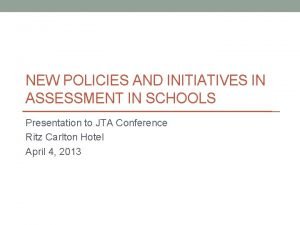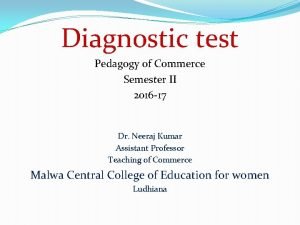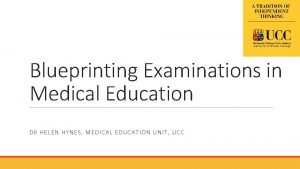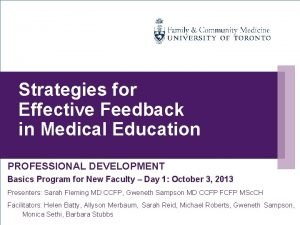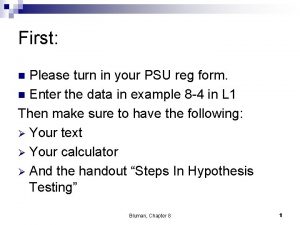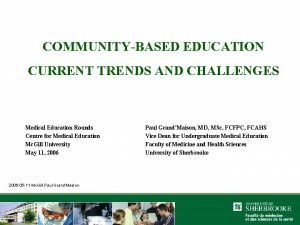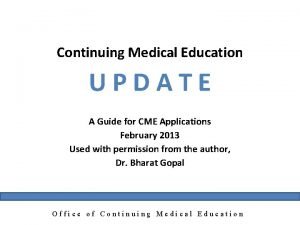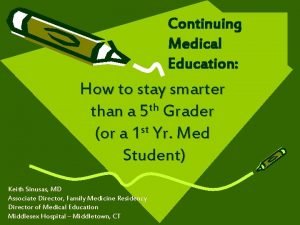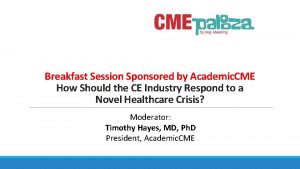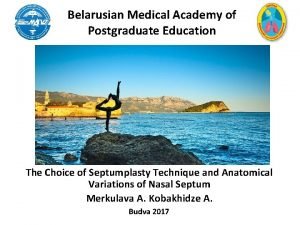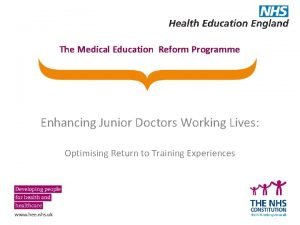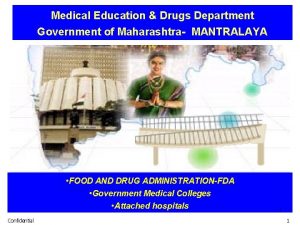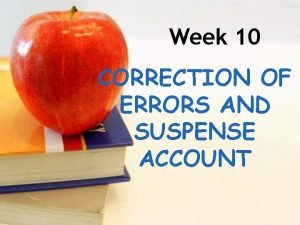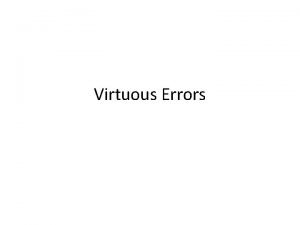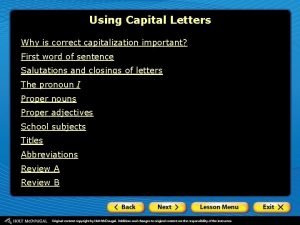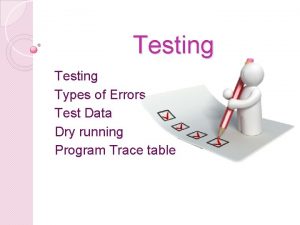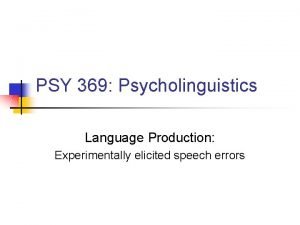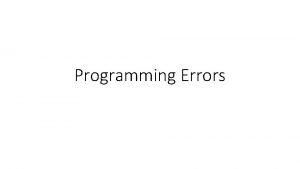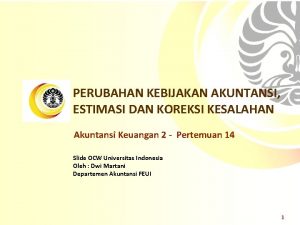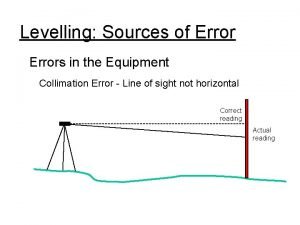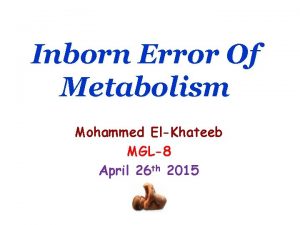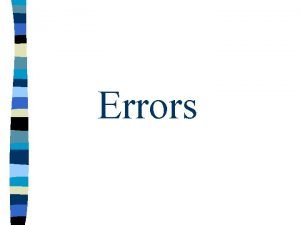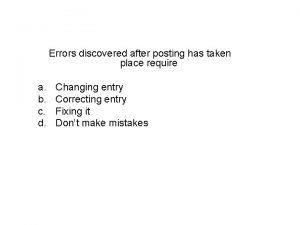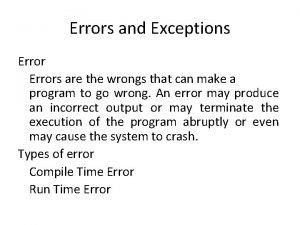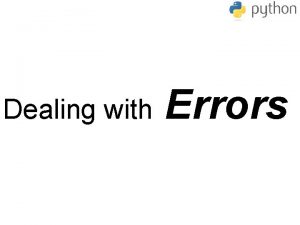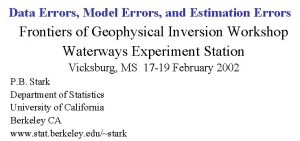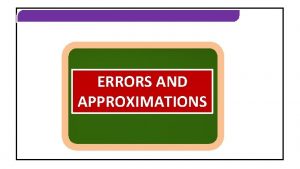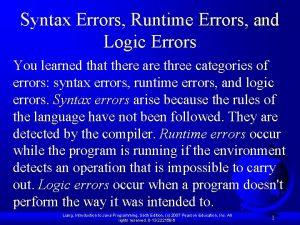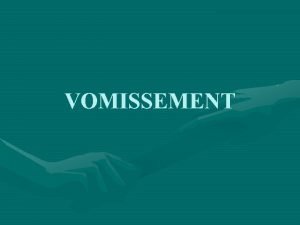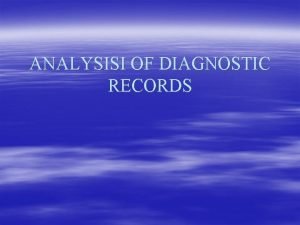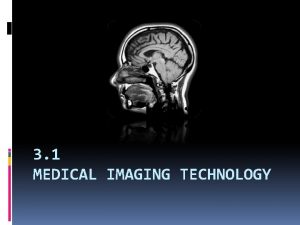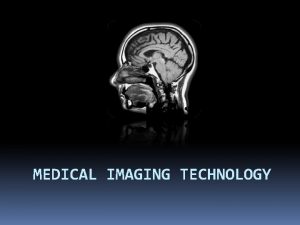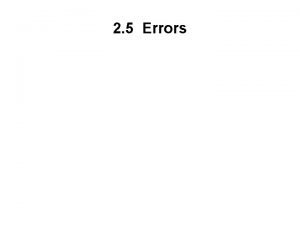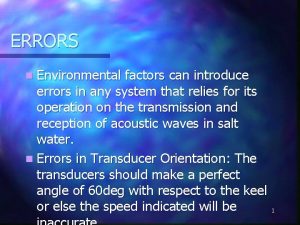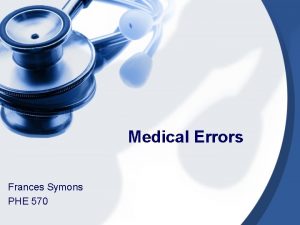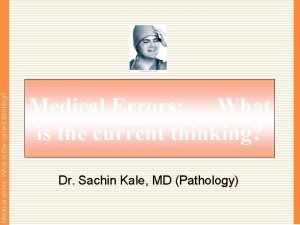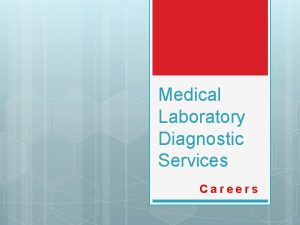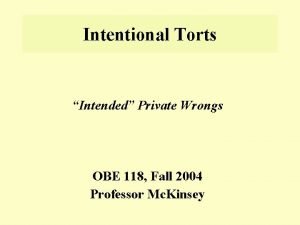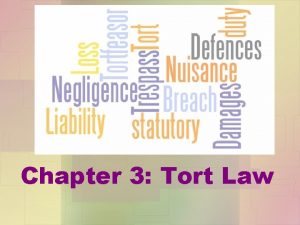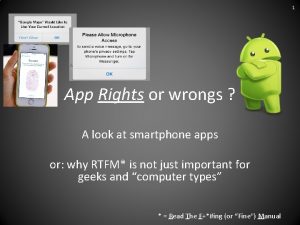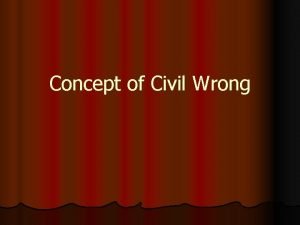Diagnostic errors in medical education Where wrongs can










































- Slides: 42

Diagnostic errors in medical education: Where wrongs can make rights Kevin W. Eva Centre for Health Education Scholarship University of British Columbia

No one likes to make mistakes

But they aren’t all avoidable


Conclusions • Mistakes are necessary when trying to enable learning • Diagnostic strategies that avoid one type of error may increase the rate of another type

Caveats • Promoting errors is not about reducing patient safety • Mistakes are not simply the result of individuals’ decision-making • Nor are they indicative of lack of dedication/ability of health professionals

er r e ch ia a e T l 3 O ut line M at 2 1 Learner

Considerations 1. Errors that arise while learners are learning new material 2. Errors in understanding how well said material was learned 3. Errors educators can use/induce to facilitate learning


Overconfidence • Premature closure • Lack of insight • God complex • Lake Woebegone ? y W h Learner See Berner and Graber (2008); Crosskerry (2002) Ma te ria l

Self-regulated learning y l • Requires deciding: g n • What to study i g s i n • How long to study r i p g r • When to stop n u S alle h c See Nelson and Narens (1994) Learner M at er ia l

Jowett, et al. (2007) Learner M at er ia l

Jowett, et al. (2007) • Proficiency is inferred from the rate of learning rather than the amount learned See Kornell and Metcalfe (2006) Learner M at er ia l

The Which fluency is better? heuristic Sessions Massed Training Spaced Training Few, Intense Many, Spread out Speed Faster Confidence Higher Satisfaction Greater Retention Longer Performance Better

Desirable difficulties • Teaching strategies that elicit more errors (and can make learning seem more difficult) are often more beneficial See Bjork (1999); Simon and Bjork (2001) Learner M at er ia l

Test-enhanced learning Percent Recall Study, Test 0, 9 0, 8 0, 7 0, 6 0, 5 0, 4 0, 3 0, 2 0, 1 0 5 Minutes 2 Days 1 Week Retention Interval Roediger and Karpicke (2006)

Summary • Errors are more likely to be made over the long term if they are not induced during learning • There is a clear need for external prompts and guidance Learner M at er ia l

er r e ch ia a e T l 3 O ut line M at 2 1 Learner

Three maxims • Feedback is good • The more immediate, often, and accurate, the better • Errors in medicine proliferate because feedback is often Learner unavailable r a Te e ch


Boehler, et al. (2006) Compliment group Feedback group Performance Rating 25 20 15 10 5 0 Pre-test Post-instruction Post-feedback

What predicts generation of learning goals? 0, 35 Standardized beta 0, 3 Overall R 2=0. 45; Eva et al. , 2010 0, 25 0, 2 0, 15 0, 1 0, 05 0 Station Observer rating Student Feedback quality NOTE: Absolute values illustrated for ease of comparison Station order Self rating

The ironic nature of selfassessment • We can’t trust it … but we should encourage it • We need to influence it … without changing it

The need for difficulties Promoting “self-assessment” should be about … (a) creating situations that will enable learners to discover the limits of their knowledge/ability (b) role modeling the habit of seeking and using data to guide continuous quality improvement (see Simon and Bjork, 2001; Eva, 2009)

Credibility may be the key “With your clinical partner … they know your strengths and weaknesses and they’re probably going to give you quite useful feedback. Maybe a consultant watched you one time. They might not have the whole picture of what you’re capable of and what you normally do” (Sargeant, et al. , 2010)

Credibility Of relationships: Engagement and awareness Of the process: Validity and authenticity Of intent: Beneficence and non-maleficence (Sargeant, et al. , 2010)

Summary • Learners rarely induce in themselves the sorts of errors that maximize learning • It’s the educator’s role to facilitate growth from errors and empower learners to make errors in a safe place Learner r a Te e ch

er r e ch ia a e T l 3 O ut line M at 2 1 Learner


The source of all evil • The use of pattern recognition by novices is not advocated for fear that “[i]nadequate experience might lead to potentially grim consequences” • See Coderre, et al. (2003) M at er ia l a Te er h c

What else could it be? Is there anything that doesn’t fit?

Overcoming the evil • “Cognitive forcing strategies … are designed to prevent clinicians from pursuing a pattern recognition path that will typically lead to error” • See Crosskerry (2002) M at er ia l a Te er h c

Norman, et al. (1989) Correct Incorrect DK Response Time 30 25 20 15 10 5 0 Student Clerk Resident GP Dermatologist

Non-exclusivity Non-analytic processes Combined Analytic processes See Eva (2005)

Ark, Brooks, and Eva (2006) Feature Oriented First Impression Combined Diagnostic Accuracy 70 60 50 40 30 20 10 0 Old ECGs New ECGs

Ark, Brooks, and Eva (2006) Feature calls Feature Oriented First Impression Combined 2 1, 8 1, 6 1, 4 1, 2 1 0, 8 0, 6 0, 4 0, 2 0 Hits Indicative Hits Not Indicative False Alarms

Summary • We need to structure experiences for students that help them recognize that exclusive reliance on nonanalytic processes does create error … • … but so does absolute aversion to those same M at er ia l a Te er h c

Strategies for doing so • Manipulating order of examples • Inducing learners to compare and contrast cases • Actively engaging learners in problem solving • See Eva, et al. (1998); Eva (2009) M at er ia l a Te er h c

The grand finale • Dominant discourse around diagnostic error: Heuristics bad • Problems arising from that discourse: • This view overlooks the fact that any strategy can lead to errors though they are of different types • Reinforces the tendency for students to want to be right rather than to learn how

“An expert is a person who has made all the mistakes that can be made in a very narrow field. ” (Niels Bohr)

“Education is learning what you didn’t even know you didn’t know” (Boorstin, 1914)

Thanks kevin. eva@ubc. ca See Eva, 2009 (AHSE) for more
 Diagnostic testing in education
Diagnostic testing in education Steps of diagnostic test
Steps of diagnostic test Doctors license number
Doctors license number Gbmc medical records
Gbmc medical records Hepburn osteometric board
Hepburn osteometric board Torrance memorial hospital medical records
Torrance memorial hospital medical records Cartersville medical center medical records
Cartersville medical center medical records Helen hynes
Helen hynes Corbs model of feedback
Corbs model of feedback Epas
Epas The medical rehabilitation education foundation reports
The medical rehabilitation education foundation reports Current trends in medical education
Current trends in medical education Target institute of medical education and research
Target institute of medical education and research Define blime
Define blime Ethics in medical education
Ethics in medical education Continuing medical education
Continuing medical education American association of continuing medical education
American association of continuing medical education Continuing medical education
Continuing medical education Belarusian medical academy of postgraduate education
Belarusian medical academy of postgraduate education Medical education reform programme
Medical education reform programme Medical education and drugs department
Medical education and drugs department Difference between formal education and als
Difference between formal education and als Differences between health education and physical education
Differences between health education and physical education Extension education is non formal education
Extension education is non formal education Error suspense account
Error suspense account Virtuous errors
Virtuous errors Letter salutation capitalization
Letter salutation capitalization Type of errors in statistics
Type of errors in statistics Errors revealed by trial balance
Errors revealed by trial balance Dry run testing
Dry run testing Grid types radiography
Grid types radiography Levelt's model of speech production
Levelt's model of speech production Different types of errors
Different types of errors Sample of product oriented performance based assessment
Sample of product oriented performance based assessment Loren french
Loren french Contoh laporan keuangan retrospektif
Contoh laporan keuangan retrospektif Sextant working principle
Sextant working principle 13 fatal errors managers make
13 fatal errors managers make Levelling
Levelling Difference between occlusion and mixed-crystal formation
Difference between occlusion and mixed-crystal formation Ornithine cycle
Ornithine cycle Errors affecting trial balance
Errors affecting trial balance What do errors discovered after posting require?
What do errors discovered after posting require?
